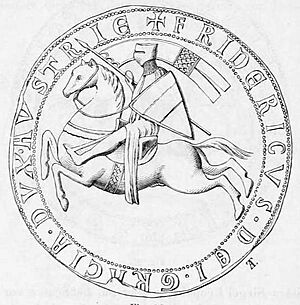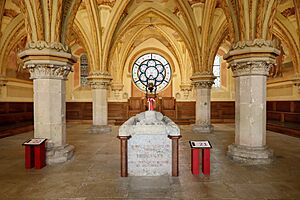Frederick II, Duke of Austria facts for kids
Quick facts for kids Frederick II |
|
|---|---|

Seal of Frederick, by God's grace Duke of Austria
|
|
| Duke of Austria and Styria | |
| Reign | 1230–1246 |
| Predecessor | Leopold VI |
| Successor | Rudolf of Habsburg |
| Born | 25 April 1211 Wiener Neustadt |
| Died | 15 June 1246 (aged 35) Battle of the Leitha River |
| Burial | Heiligenkreuz Abbey |
| Spouse | Sophia Laskarina Agnes of Merania |
| House | House of Babenberg |
| Father | Leopold VI |
| Mother | Theodora Angelina |
Frederick II (born 25 April 1211 – died 15 June 1246) was known as Frederick the Quarrelsome. He was the Duke of Austria and Styria from 1230 until his death. He was the fifth and last duke from the House of Babenberg family.
Frederick was killed in a battle, and he did not have any sons to take over. This led to big changes for Austria.
Contents
Frederick's Family Life
Frederick was born in Wiener Neustadt. He was the second son of Duke Leopold VI of Austria and Theodora Angelina, a princess from the Byzantine Empire. When his older brother Henry died in 1228, Frederick became the only heir. This meant he would inherit the lands of Austria and Styria.
Frederick's first wife was a Byzantine princess named Eudokia Laskarina. They divorced by 1222. In 1229, Frederick married Agnes of Merania. She came from a powerful family and brought him control over lands in Carniola and the Windic March. Because of this, Frederick called himself "Lord of Carniola" from 1232. However, this marriage also ended in 1243 because they did not have any children.
Frederick's Time as Duke
Frederick became duke in 1230 after his father died. He was very proud of his family's Byzantine roots. People soon called him "the Quarrelsome" because he was a tough ruler. He often fought wars with his neighbors. These included the kingdoms of Hungary, Bavaria, and Bohemia. Even some of his own nobles in Austria rebelled against him when he first became duke.
One of his biggest problems was with the Holy Roman Emperor, also named Frederick II. The Emperor was upset because Duke Frederick refused to attend important meetings. Duke Frederick said he didn't have to go because of special rights given to Austria. The Emperor also didn't like that Frederick was fighting with King Béla IV of Hungary.
When Duke Frederick refused to attend another meeting in 1235, Emperor Frederick II declared him an outlaw. This meant the Emperor allowed King Wenceslaus I of Bohemia to invade Austria. The city of Vienna opened its gates to the Bohemian and Bavarian armies. For a few years, Vienna even became a free city, directly under the Emperor's rule.
However, Duke Frederick managed to keep control of a small part of Austria from his home in Wiener Neustadt. In the same year, he created a law called the Landrecht. This law said that all people in Austria had to defend the country if it was invaded.
In 1239, things changed. Duke Frederick became an important ally of Emperor Frederick II.
Fighting the Mongols
In 1241, Duke Frederick faced a huge challenge: the Mongols. These powerful warriors invaded Europe. After they attacked Hungary, King Béla IV asked for help. Duke Frederick sent a small group of knights to help the Hungarians. They won a small battle against the Mongols, but then left due to disagreements with King Béla IV.
Soon, the Mongols came to Austria. A small group of Mongol raiders attacked Wiener Neustadt. But Duke Frederick, along with his knights and allies, defeated them and drove them out. The Austrians also defeated the Mongols again near the River March. After these defeats, the Mongols never tried to invade Austria again.
Later Years and Death
Duke Frederick settled his conflict with Bohemia. His niece, Gertrude of Babenberg, was engaged to the Bohemian king's son.
Frederick also talked with the Emperor about making Vienna a bishopric and Austria a kingdom. But there was a condition: his niece Gertrude had to marry the fifty-year-old Emperor. In 1245, the plans were made. However, Gertrude, who was still a teenager, refused to marry the Emperor.
In the year before he died, Duke Frederick gained control over the March of Carniola. But after his death, this land went to the Duke of Carinthia.
Duke Frederick's big plans ended when he died in the Battle of the Leitha River in 1246. This was another border fight he started with the Hungarian king, Béla IV. He is buried at Heiligenkreuz Abbey.
Frederick's Legacy
Since Austria's laws allowed women to inherit land, Frederick's sister Margaret and his niece Gertrude could have become rulers. After Frederick died, Gertrude first married her fiancé, but he died the next year. She married two more times, but neither husband could keep control of Austria.
Later, the Bohemian royal family tried to claim Austria. They arranged for Gertrude's aunt Margaret to marry King Wenceslaus's son, Ottokar II. He was more than twenty years younger than her.
Austria then became a battleground between the Bohemian and Hungarian families. Ottokar won at first, but he was later defeated by Rudolf I of Germany from the House of Habsburg in 1278. This marked the start of Habsburg rule in Austria.
Frederick the Quarrelsome was the last duke from the Babenberg family. His death ended an important time in the history of Austria. He was known for his big plans, but his difficult personality often got in the way.
Frederick was also the first Austrian duke to use the red-white-red colors as his coat of arms. He did this to show his power over local nobles and his independence from the Emperor. The red-white-red design first appeared on a seal in 1230. An old writer named Jans der Enikel said that Duke Frederick wore a red-white-red outfit at a special ceremony in Vienna in 1232.
See also
 In Spanish: Federico II de Austria para niños
In Spanish: Federico II de Austria para niños


